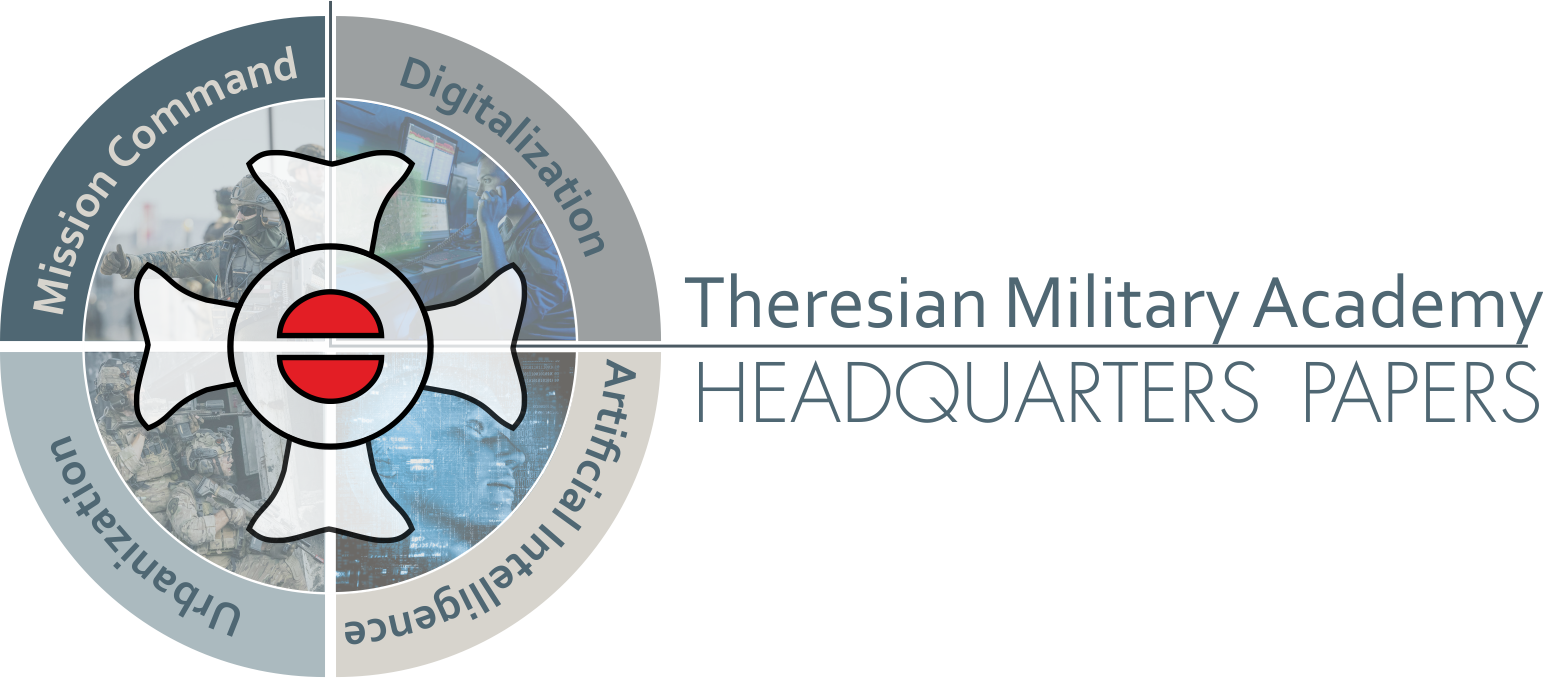#UOET23 Proceedings - The Quadruplicity of Future Military Command
Headquarters Papers Online - Special Issue
The Quadruplicity of Future Military Command
Urbanization, Digitalization, Artificial Intelligence and Mission Command
Author:
Peter HOFER, Theresan Military Academy - Institute of Advanced Officer Training
Abstract:
Future military command will be influenced by three core elements, namely urbanization, digitalization and artificial intelligence. To cope with the associated challenges, mission command must be cultivated and remain the primary leadership principle in order to reduce complexity and enable successful mission accomplishment. This opinion paper outlines a proposal for the human-machine interaction agent Comprehensive Operational Memory And Neural Network Deliberation.
Stress Modelling based on Specific Stress Characteristics of Various Military and Civil Forces for a Real-Time Stress Monitoring
Authors:
Anna WEBER, Alexander ALMER, Florian HAID, Lucas PALETTA, Michael SCHNEEBERGER (JOANNEUM RESEARCH)
Philip KLÖCKL, Dominik EDER (Strykerlabs)
Dietmar WALLNER, Paul GLANZ (FH JOANNEUM, University of Applied Sciences)
Oliver KÜHR (Austrian Armed Forces - Armed Forces Sports Centre)
Gerald BAUER (Federal Ministry of Defence - Science, Research and Development Division)
Thomas HÖLZL (Federal Ministry of Defence - Armed Forces Sports Division)
Abstract:
In recent decades, the development of autonomous cyber-physical systems for a wide range of tasks has been the focus of research activities for military organisations. Humans are still at the center of deployed sociotechnical systems and therefore extensive development projects have been launched for the psycho-physiological monitoring, with new possibilities arising from innovative developments in the field of biosensor technology. The aim is to optimise human performance in the field and the interaction between man and machine with intelligent mission equipment.
Crowd Counting and Localization for Subsurface Operations
Authors:
Roland PERKO, Richard LADSTÄDTER, Michael HUBER, Sead MUSTAFIC, Alexander ALMER, Manfred KLOPSCHITZ (JOANNEUM RESEARCH)
Abstract:
Accurate crowd counting and localization are particularly important in subsurface environments to assist decision-makers in critical security situations. Thus, we introduce an approach based on artificial intelligence to count and localize individuals, both emergency personnel and uninvolved persons, to resolve crowded situations. Our method needs a single image to predict the overall crowd count, density map, and precise locations of each individual, which could then be mapped to a common operational picture. With the additional precise person location information more concise end user information can be made possible, while simultaneously improving absolute counting information.
Multi-Sensor Visibility Study Based on a Hot Smoke Experiment in a Tunnel
Authors:
Richard LADSTÄDTER (JOANNEUM RESEARCH), Stephan SCHRAML (AIT Austrian Institute of Technology), Nikolaus STUDNICKA (Riegl Laser Measurement Systems)
Abstract:
Emergency situations in tunnels require rescue teams supported by unmanned ground vehicels (UGV) to operate also in smoked tunnel areas. Such UGVs are equipped with various sensors (e.g. cameras, LiDAR or RADAR) to be able to navigate and quickly provide a common operational picture. Within the research project ROBO-MOLE experiments have been performed at the Zentrum am Berg at the Styrian Erzberg to directly compare the visibility range of RGB and thermal camera, LiDAR and RADAR in a hot smoke scenario.
NIKE BLUETRACK. Improved Real-Time Real-World Capabilities for Underground Tracking
Authors:
Markus WATZKO, Karin MASCHER, Philipp BERGLEZ (TU Graz, Institute of Geodesy, Working Group Navigation)
Abstract:
This paper is a follow-up to NIKE BLUETRACK: Blue Force Tracking in Underground Structures. In the last paper, the principles for tracking agents in underground structures were presented. However, two aspects were not described: data acquisition and real-time performance. This paper highlights the usage of the Robot Operating System to ensure real-time capabilities of the positioning system. Finally, the final performance tests and evaluations on agents in combat scenarios are presented.
Multi-Dimensional and Multi-Domain Battlespace Complexity Pre-Evaluation for Urban Areas of Operation
Author:
Clemens STRAUß
Abstract:
The geography dictates the operational tactics and the sooner the geographical particularity of the area of operations is known, the better leaders can prepare for that. Beside mountainous regions, forests and open landscape, urban areas have the potential to be very complex: structures along all three spatial axes and filled with public, administrative or private content. Using open-source data, the degree of urban complexity can be pre-evaluated by tools of geospatial statistics to provide simple classification for military decision-makers on a map.
